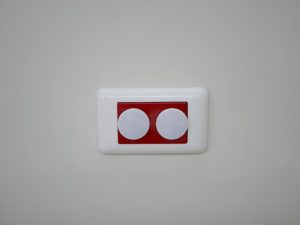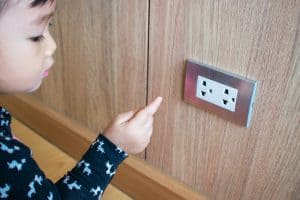17 Aug How to Child-Proof Your Electrical Outlets and Cords
Keep Your Little Ones Safe, With Quality Child-Proofed Equipment.

Electrical outlets and cords are to children like flames are to moths: they’re attracted to them.
Whether it’s because of their curious nature or because they want to drive their parents crazy (of course, the latter isn’t true, but for parents, it can definitely feel that way), there’s one thing that’s certain: children and electricity don’t mix.
Once your little one becomes mobile, it’s exceedingly important to protect them from the dangers that lurk around your home, especially electrical outlets and cords.
Think your baby or toddler won’t play with the electrical outlets or cords in your home? Think again! The National Fire Protection Agency reports that more than 2,400 children are injured every year as a result of playing with electrical receptacles each year, and an estimated 6 to 12 deaths occur because of these accidents; statistics that prove little ones curiosity about electricity can be exceptionally dangerous. How can you prevent your tot from becoming one of these statistics? – By child-proofing the electrical outlets and wires in your home.
But how do you childproof the electric receptacles and wires in your home? Here’s a look at how you can protect your tyke while still enjoying the benefits that electricity offers.
Locate the Electrical Hazards
First things first: assess your house to determine where the electrical hazards lie.
Outlets and cords are located in virtually every room in your home, so make sure you go through every space and do a thorough inspection. You might think that cords and receptacles that are located high up or situated in inconspicuous spots, such as above countertops, aren’t a danger, but it’s surprising how crafty little ones are; a clever toddler can easily pull a chair into your kitchen and use it to scale a countertop and reach an outlet.
Try as you might, it’s impossible to keep your eyes on a baby or toddler 24/7. Children can get into a world of trouble in the blink of an eye, which means that every electrical outlet and cord in your home is a serious danger and needs to be child-proofed.
Consider Tamper-Resistant Electrical Receptacles
Tamper-resistant electrical receptacles, or child-proof outlets, feature spring-loaded shutters that automatically close the slots in the outlet when they are not being used. In order to open the shutters and permit the flow of electricity, an even amount of pressure needs to be placed on both springs at the same time. So, if your child pushes a finger or a toy into one of the openings in an outlet, the shutter won’t open and he or she will not contact an electrical current.
If your home was recently built or renovated, it’s likely that you already have tamper-resistant electrical receptacles. In 2008, the National Electrical Code mandated the use of these outlets in newly built or renovated homes; however, don’t assume that you have these receptacles. Sadly, many contractors don’t adhere to this mandated protocol and install standard outlets.
Check the outlets in your house. If they feature a label that reads “tamper-resistant” or “TR”, you’re safe. If they don’t or you aren’t sure, have a licensed electrician inspect them and consider replacing any standard outlets with tamper-resistant models.
Install Self-Closing Outlet Covers
For a more cost-effective option, install self-closing outlet covers. These covers are similar to tamper-resistant receptacles in that they have spring-loaded covers that close over the outlet slots when they are not being used. As soon as you unplug an appliance, the cover will automatically slide back in place.
Installing sliding plate covers is easy. Simply pop off the cover on your outlet, replace it with one of these covers and you’re ready to go.
Use Plastic Outlet Covers
If you’re looking for the easiest and most affordable way to childproof your outlets, plastic covers are a good option. Just slide them right into the slots on your outlets and you’re all set. For a few bucks and a couple of minutes of your time, you can protect your little ones from the dangers of electricity. However, it’s important to note that you have to remember to put these covers back on when you’re done using an outlet. Furthermore, if your little one is extremely curious and has unusual strength and dexterity, there is a chance that he or she could pry them off.
Secure Your Electrical Cords
Electric cords are also a serious risk for babies and toddlers. A teething baby could chew on one and sustain shock, a toddler could pull one out of the wall and possible suffer a shock or pull down anything that’s plugged into the cord, or they can be a tripping hazard, for example.
Additionally, if the cord becomes dislodged, the outlet will be exposed, which can put your child in danger.

Wrapping It Up
Electrical outlets and cords can certainly make life a lot more convenient, but if you have small children, they can pose serious risks. To keep your little ones protected and enjoy the benefits of electricity, make sure you take the time to properly child-proof the outlets and cords in your home.
If you want to ensure a thorough job, contact a professional electrician. The fully licensed and insured electricians at Marra Electric will conduct a thorough inspection of your home’s outlets and covers and make sure that your little ones are safe and secure.


Sorry, the comment form is closed at this time.